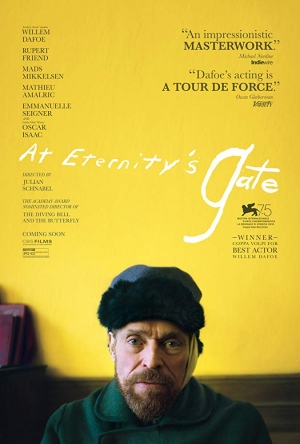“Willem Defoe was incredible as Vincent. You feel the anxiety
and madness and intelligence of Vincent. Visually the film is
often disturbing to watch but then you must think that
Schnabel was going for the decline of Vincent. I loved the
discussions. Vincent’s discussion with the Priest and the talk
with Gauguin about art and painting. The film keeps the viewer
off kilter hoping for the best but knowing the outcome is the
worst.”
“Overly self conscious film. Well acted.”
“Didn’t work for me. This film was so full of itself. Busy being
artsy, all over the top. Frankly every gimmick seen in other
experimental filmography mashed together. Shaky camera,
multiple POV’s, heavy-handed score, blurred focus,
schizophrenic shots, black and white sections, stereotypical
shots. I could go on but I could never get beyond Schnabel to
Van Gough.” Jeanne K
“The cinematography made me dizzy. Simulation of Van
Gough’s state of mind. Repetitive scenes of walking feet began
to get tiresome. Schnabel’s direction is reflective of his art.”
Emma Lewis
“I loved it! The vision of Vincent was enhanced so poignantly by
the frenetic camera the dissonant music and wandering eyes of
Defoe. There’s been a lot seen and written about Van Gough.
This captured his essence beautifully.”
“Did not know what to think. So glad for the discussion.”
“The cinematography was both gorgeous and disorienting, a
perfect metaphor for a great artist’s ability to show us the
world in a completely new way. The scene of Vincent in his
coffin surrounded by his paintings deciding which is worth
bringing home chillingly captures the gap between the creation
of art and the business of selling them.”
“Definitely a demanding film from the audience. We are forced
to stare into the eyes of actors who are staring in to a camera
so we become Van Gogh. I’m not sure I want to be Van Gogh.”
“This was adventurous, filmmaking, certainly as far from a
biopic as I can imagine. Does bio-portrait work?”
“Although the script – meaning dialogue – was cleverly and
often insightfully written I always felt I was hearing actors
delivering scripted lines.”
“Constant motion of the hand-held camera was distracting.
First film that made me not want to go to France. Gives me the
feeling for what it must be like to be mentally ill.”
“Of all the films on Van Gogh this is the best.”
“Defoe is much to old for the role. Editing was confusing. Film
was a bit over indulgent. Only loosely based on facts.”
“Van Gogh’s discussion on art and religion bring to mind
Salieri’s discussions with the priest in AMADEUS. But AMADEUS
is a much more approachable movie yet still a brilliant portrayal
of an artist without the artsy-ness.”
“Rightfully named, it went on for eternity!”
“A brilliant film. Thank you.”
“Including the story of the two boys and the gun and whether
he was shot or not should never have been part of this movie.
The events of his life are unimportant (and largely ignored in
the rest of the film) if you’re discussing an artist and how they
view the world and turn it into paint on canvas. Leave
conspiracy theories to the tabloids.”
“Liked and disliked the cinematography.”
“A realistic depiction of a troubled soul. The use of color
depicted the manic mood of the character. The sound volume
was over done and did not serve the picture, as if it was trying
to depict the madness - it does not work.”
“Visually beautiful.”
“The film was a wonderful, amazing work of art. It was a
painting that came alive via actors, music, photography.”
“One of the best films about art and the artist’s process.”
“I loved the shots of Vincent walking through the fields
portraying how and what the artist saw to make the paintings.
It was hard to watch due to the hand-held camera work. Bravo
Willem Defoe! Watching him paint his shoes and all the other
portrait flowers and fields was wonderful! I think Schnabel did
it to show the artist’s thoughts and process to produce his
work. The cinematography was beautiful!”
“Glad I sat through the credits as I always do, but not sure how
the quotes and discussions of the color ‘yellow’ add to this
cinematic portrait.”







